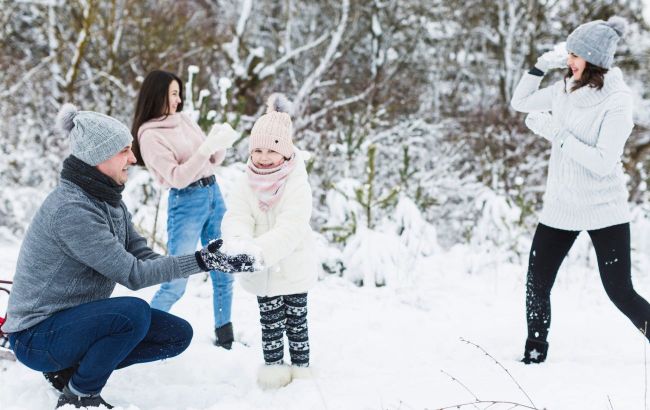Winter fun 100 years ago — Lost pastimes of Ukrainian ancestors
 Photo: Winter games in ancient Ukraine (Freepik)
Photo: Winter games in ancient Ukraine (Freepik)
While modern children spend their time on TikTok, Ukrainian boys and girls of the past competed on ice, slid down frozen hills, and staged real snow battles. For our ancestors, winter was not a season of gloom but a time for the loudest games, tournaments, and jokes. Folk games brought the community together, strengthened the body, and allowed people to endure the cold with a smile. Here is how lively winter games warmed our ancestors and the kinds of pastimes they enjoyed.
While today's winters are associated with hot cocoa, cozy blankets, and another Netflix season, for our forebears, it was quite the opposite. Frost was not a reason to hide indoors but an invitation to go outside.
Ukrainians saw the cold as a stage for fun, where life played at full volume. The winter games were a mix of sport, carnival, and ritual, as they strengthened the body, united the community, and carried symbolic meaning: whoever laughed in the cold would be lucky.
Battle of the fortresses (snowball fights, Ukrainian style)
Imagine a snow-covered village where groups of youth gather for a "fortress battle." Two teams build snow fortifications, place "guards," and start a real assault.
However, it was not chaotic snowball throwing. Everything had rules: prisoners, winners, and tactics. This game embodied the struggle between good and evil, light versus darkness, which, in folk imagination, clashed most vividly in winter.
Sliding down hills
Sliding down hills is a tradition dating back to Kyivan Rus. People rode sleds, troughs, or even just wooden boards. They said, "The farther you go, the luckier you'll be," because a good run symbolized fortune and a bountiful harvest. Often, these contests evolved into full-fledged festivals featuring music, dancing, and jokes lasting into the night.
Ice races
On frozen ponds and rivers, ice became the arena for "ice races." Young men lined up, glided, jumped, and demonstrated agility and strength. Whoever stayed on their feet the longest earned the respect of the community. This was a way to test oneself before spring work began.
Winter games in Ukraine a hundred years ago: forgotten pastimes of our ancestors
 Our forebears considered winter a time for play and constant movement (photo: Freepik)
Our forebears considered winter a time for play and constant movement (photo: Freepik)
Metelytsia (the Blizzard)
When the wind blew snow across the streets, people danced the "Metelytsia." You might think it was just a dance, but it had a deeper meaning. Participants formed a circle, spun faster and faster, singing until they "scattered" across the snow.
Boys chased girls, creating a flirtatious heat like a fire in the blizzard. This game symbolized renewal, purification, and the world moving forward.
The game "Koza" (Goat)
One boy dressed as an animal with a wooden head, while others played devils, shepherds, or elders. The "goat" would fall, "die," and then resurrect to the singing of carolers. The whole village laughed, danced, and celebrated. This game was more than entertainment, as it symbolized new life and the sun's rebirth after the longest night of the year.
Snow chain
Younger children played "snow chain": holding hands and making their way through snowdrifts, trying not to break the line. The leader would suddenly change direction, turning it into a whirl of shouts, laughter, and falls. The lesson was clear: stay together, and you can withstand any blizzard.
 In the old days, winter was fun for both children and adults (photo: Freepik)
In the old days, winter was fun for both children and adults (photo: Freepik)
"I burn, I burn, I blaze"
There were also "fire" games, such as "I burn, I burn, I blaze." Near the bonfire in the cold, everyone ran from the leader, and whoever was caught became the "fire." This was a winter purification ritual, where laughter acted as protection against evil.
Hold or not?
For the bravest, there was the skating game "Will the ice hold or not?" Boys tested the ice, stood, and glided under the watchful eyes of elders. It was not about risk but initiation: demonstrating trust in nature, community, and one's own courage.
Tug-of-war
On Epiphany, teams gathered for tug-of-war: snow, shouting, strength, and a symbolic struggle between winter and spring. Victory went not to the stronger side but the merrier, because after falling into the snowdrift, everyone laughed, hugged, and invited warmth to arrive sooner.
Sliding with fire
On the night before Epiphany, boys rolled lit wheels or torches down hills. Fireballs flew through the darkness, cutting through the frosty air. This was an ancient ritual: the sun rolls toward spring. It was a Ukrainian version of a fire show, but it was real.
Earlier, we revealed how our ancestors celebrated weddings and which traditions have survived to this day.
Sources: Ukrainian Institute of National Memory, Vseosvita, EthnoSvit

